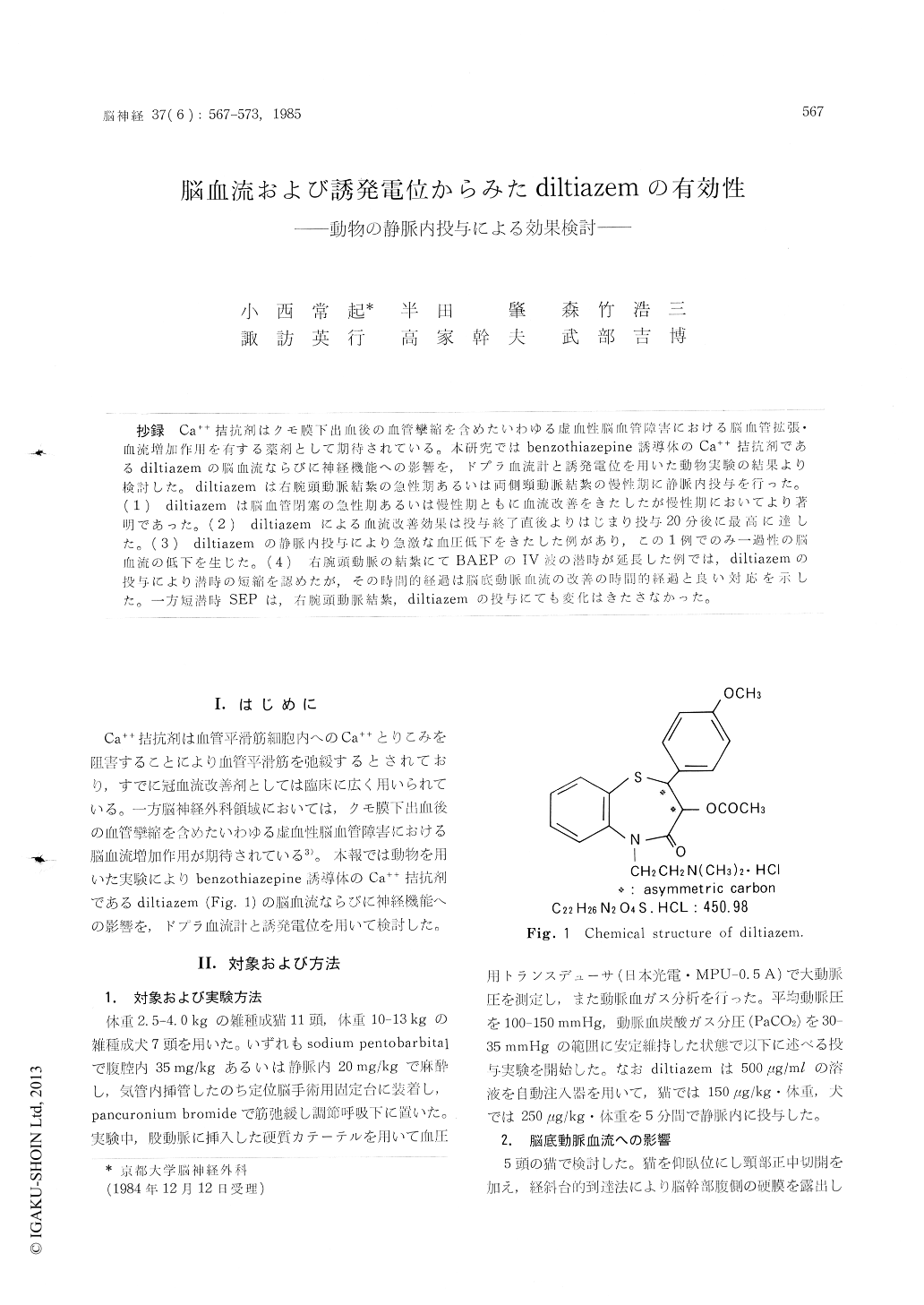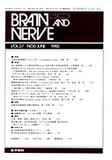Japanese
English
- 有料閲覧
- Abstract 文献概要
- 1ページ目 Look Inside
抄録 Ca++拮抗剤はクモ膜下出血後の血管攣縮を含めたいわゆる虚血性脳血管障害における脳血管拡張・血流増加作用を有する薬剤として期待されている。本研究ではbenzothiazepine誘導体のCa++拮抗剤であるdiltiazemの脳血流ならびに神経機能への影響を,ドプラ血流計と誘発電位を用いた動物実験の結果より検討した。diltiazemは右腕頭動脈結紮の急性期あるいは両側頸動脈結紮の慢性期に静脈内投与を行った。(1) diltiazernは脳血管閉塞の急性期あるいは慢性期ともに,血流改善をきたしたが慢性期においてより著明であった。(2) diltiazemによる血流改善効果は投与終了直後よりはじまり投与20分後に最高に達した。(3) diltiazemの静脈内投により急激な血圧低下をきたした例があり,この1例でのみ一過性の脳血流の低下を生じた。(4)右腕頭動脈の結紮にてBAEPのIV波の潜時が延長した例では,diltiazernの投与により潜時の短縮を認めたが,その時間的経過は脳底動脈血流の改悠の時間的経過と良し対応を示した。一方短潜時SEPは,右腕頭動脈結紮,diltiazemの投与にても変化はきたさなかった。
The effect of intravenous administration of diltiazem on cerebral circulation and brain func-tion were studied in animals.
Diltiazem, at a dose of 150 pg/kg BW, was administered intravenously over a period of 5 minutes begining 30 minutes after ligation of the right brachiocephalic artery in 9 cats in order to investigate its effects in the acute stage of cerebral ischemia. In 5 animals, mean arterial blood pressure was recorded and blood flow in the basilar artery was measured trans-durally by use of an ultrasonic Doppler flow-meter. Mean arterial blood pressure began to elevate immediately after ligation of the right brachiocephalic artery, but the degree of eleva-tion was minimal. It began to fall during dil-tiazem injection and returned to the preadmini-stration value 30 minutes after injection. Basilar artery flow decreased slightly during injection of diltiazem, but began to increase after com-pletion of injection. The increase relative to the preadministration value was 62±31% 10 minutes after injection, 88±38% 20 minutes after, and 24±53% 30 minutes after. The short latency somatosensory evoked potentials (short latency SEP) recorded in the other 2 animals showed no noticeable change either in ampli-tude or latency during the same procedures. In 1 of 2 animals in which brainstem auditory evoked potentials (BAEP) were monitored, the latency of peak IV increased after ligation of the right brachiocephalic artery, and decreased 20 minutes after injection of diltiazem. In theother animal no change was noted.
To investigate its effectiveness in the chronic stage of cerebral ischemia, diltiazem was ad-ministered intravenously at a dose of 250f/kg BW over a period of 5 minutes, 2 weeks after ligation of the bilateral common carotid arteries in 5 dogs. Mean arterial blood pressure was re-corded and flow in the superior sagittal sinus was measured transdurally at its posterior end by use of an ultrasonic Doppler flowmeter. Al-though mean arterial blood pressure decreased slightly during and immediately after injectionof diltiazem it returned to the preadministration value about 30 minutes after the injection. The sinus flow began to increase immediately after the injection of diltiazem. The increase relative to the preadministration value was 80±39% 10 minutes after injection, 110±46% 20 minutes after, and 90±63% 30 minutes after.
These results suggest that diltiazem may im-prove brain function as well as cerebral circu-lation in both the acute and the chronic stage of cerebral ischemic disorders.

Copyright © 1985, Igaku-Shoin Ltd. All rights reserved.


